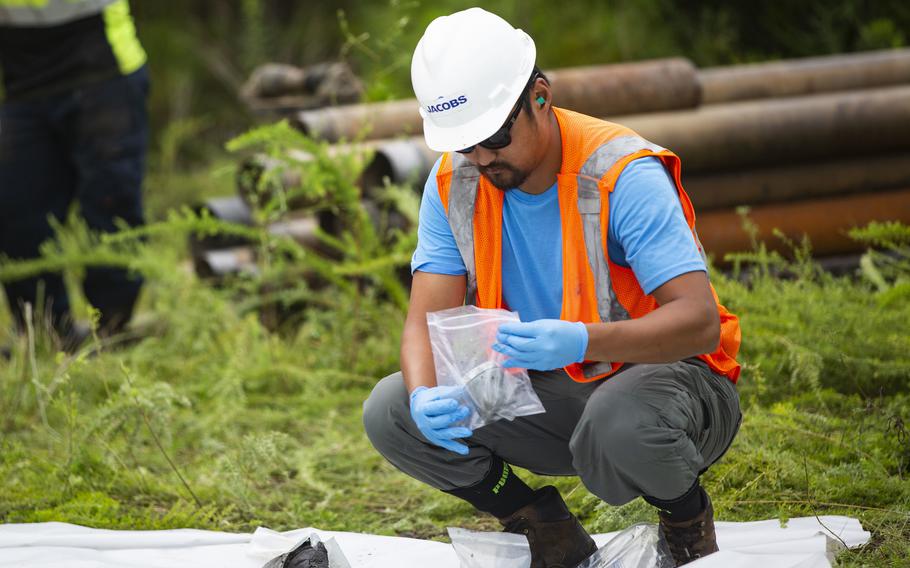
A radiological engineer gathers soil samples to be tested for per- and polyfluoroalkyl substances (PFAS) on Marine Corps Base Camp Lejeune, N.C., Aug. 19, 2020. (Christian Ayers/U.S. Marine Corps)
(Tribune News Service) — First-of-its-kind research at the University of Massachusetts Amherst will explore how women’s breast tissue is affected by exposure to so-called “forever chemicals.”
The research will be funded with a two-year, $405,000 grant from the National Institute of Environmental Health Sciences, the university said in a statement Wednesday.
“Our overall goal is to understand if PFAS contribute to breast cancer development,” Katherine Reeves, the associate dean of graduate and professional studies and professor of epidemiology at UMass’ School of Public Health and Health Sciences, said in a statement.
State and federal lawmakers have been trying for years to get per- and polyfluoroalkyl substances, more widely known as PFAS chemicals, out of public water supplies and the supply chain. The chemicals do not break down naturally.
The chemicals are used for a variety of purposes, including making waterproof cosmetics, stain-resistant fabrics and carpeting and non-stick cookware. They’re also used in fire-fighting foam at military installations, leading to contamination at scores of military bases.
The chemicals pose a significant public health risk. They’ve been linked to cancer and other serious health problems, the Pennsylvania Capital-Star reported in 2020.
Legislation now before the Massachusetts Legislature would ban the use of PFAS in most products to prevent new contamination, require sellers to inform customers if PFAS chemicals are present in their products, create new programs to clean up contamination that already exists, and would have the state regulate PFAS chemicals as one class rather than individually, State House News Service reported in June.
“As long as we keep making and using things with PFAS, we will keep contaminating our bodies and the environment with ever-increasing amounts of PFAS. The only solution is to turn off the tap,” Laura Spark, the senior policy advocate at Clean Water Action, told a legislative committee during a June hearing, according to State House News Service.
According to Reeves, nearly everyone in the U.S has some exposure to PFAS.
“We’re exposed to them in a variety of ways,” Reeves said. “Drinking water is certainly a very common one. Even though these chemicals are being phased out, we’re still using the consumer products that have these — think of the couch you bought 15 years ago that you Scotch-Guarded. You’re still being exposed. And the health effects are not entirely known.”
Previous studies on animals have shown that the chemicals adversely impact mammary gland development and function, according to Reeves.
Some studies among humans have shown that women with higher exposure to PFAS chemicals breastfeed for a shorter period, possibly “because their breasts stop producing milk,” Reeves said.
In the new research, Reeves will use preexisting data and specimens provided by the Susan G. Kamen for the Cure Tissue Bank, which includes 9,000 breast tissue samples donated by healthy volunteers, along with their medical and reproductive histories, UMass said in its statement.
Reeves and her team will crunch data from 286 postmenopausal breast tissue donors who also provided a blood sample and gave access to their mammograms and measurements of their terminal duct lobular units. The ducts produce milk after childbirth, “and the ‘involution,’ or turning on of that process, happens naturally with aging,” UMass said in its statement.
“Most breast cancers come out of these terminal ductal lobular units, and a greater degree of involution is associated with a lower breast cancer risk,” Reeves said.
Researchers will measure concentrations of the five most common PFAS chemicals in the blood serum samples and try to determine whether they see “an association between the concentration of PFAS that women have circulating and the level to which there is involution of the breast,” Reeves said.
“We’re expecting to see that PFAS concentrations will be associated with less involution, meaning that there is a higher breast cancer risk,” Reeves said.
The researchers also will use the volunteers’ digital mammogram files to examine breast density, according to UMass.
“We’ve known for years that higher mammographic density is related to an increased breast cancer risk,” Reeves says. “And we’re going to ask the question, is PFAS concentration in the blood related to the density that we see in the breast.”
According to Reeves, higher PFAS concentrations associated with greater breast density would point toward a higher risk for breast cancer, though it’s possible that “PFAS exposure itself is associated with denser breasts,” according to Reeves, who added that other factors, such as genetics and weight, are involved.
“We’re taking advantage of these well-established biomarkers of future breast cancer risk to look at associations between PFAS and those biomarkers,” Reeves said.
According to UMass, the eventual findings from the research also likely will “foreshadow the long-term effects of new, similar chemicals as the legacy PFAS chemicals are phased out. This information may inform public health guidelines and new policies related to these classes of chemicals.
“It’s too early for us to study the health effects of these newer chemicals, but the mechanisms involved with these legacy chemicals can shed light on the health effects that we might expect to see from the newer chemicals that are being introduced today,” Reeves said.
©2023 Advance Local Media LLC.
Visit masslive.com.
Distributed by Tribune Content Agency, LLC.